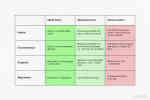Step 2 of 4•12 minutes read
What is the Risk Assessment Process?
At its core, a risk assessment is a document, contained within the ship's Safety Management System (SMS), that is completed for every task expected to be carried out onboard. This can be as small as mopping the decks in the galley right up to the handling of mooring ropes during berthing operations.
The use of risk assessments is mandatory under the International Safety Management (ISM) Code, hence their inclusion in the SMS. It is incumbent upon all crew members to know how to access, fill in, and check any risk assessments pertinent to the tasks they are performing.
Hazard Identification
The first step of any risk assessment, whether you are creating a new assessment or reviewing an existing one, is to identify all of the hazards associated with that task, the area of work, and the personnel involved. This is best done by a group rather than an individual, as people will spot different hazards due to their own perspective and experience. All of the hazards should be agreed upon and then recorded on the risk assessment paperwork.

The deck manifold of a chemical tanker. Photo Jörgen Språng.
As an example, working in the area shown, potential hazards could be:
-
Falling overboard.
-
Tripping on uneven grating.
-
Chemical burns from spills.
-
Hypothermia from cold weather exposure.
This list is not exhaustive but exemplifies the types of hazards that can be taken into account during a risk assessment process.
The Two Factors of Risk Assessment
The risk is defined as a combination of two factors: the likelihood of an accident, and the seriousness of its consequences.
-
The likelihood of an accident occurring due to a particular hazard.
-
The severity of an accident resulting from that same hazard.
All hazards identified should be assigned a "risk score" according to both of these factors.
Likelihood Rating
The likelihood rating is assigned based on the criteria: very unlikely, unlikely, likely, and very likely. This is often then converted into a numerical figure to be able to objectively assess the risk.
The chance for an occurrence of an individual during their working life is less than 1%.
An occurrence typically appears once during an individual's working life.
An occurrence typically appears once every five years.
An occurrence typically appears once every six months or more often.
Severity Rating
The seriousness or severity rating has the corresponding categories: slight harm, moderate harm, and extreme harm. Severity is estimated based on the consequence of the hazard's impact only, which can often be a morbid topic. For instance, falling from a height over 2 meters should always be assigned a severity rating of extreme harm, because the worst outcome is death. The severity rating should be assessed for the impact on the crew, the marine property, and the environment where applicable.

An example of the seriousness ratings. These may differ on your vessel so you should consult your SMS for more information.
Risk Categorisation and Calculation
By combining the "score" assigned to the two factors of risk and severity, we can calculate the estimated risk for each hazard. This can then be checked against a matrix to determine if the risk is acceptable and, if so, the work may continue.
If the harm of a particular incident is estimated to be slight, and it is very unlikely that it will occur, the risk is considered low. On the other hand, if the harm is extreme and very likely to occur, the risk is considered to be very high.
Risk Assessment Calculation
If one is using numbers instead of categories, the risk is calculated. This can be a preferred method as it is easier to compare one risk to one another.
R
P
C
Calculation
To give an example, let's say that you want to cross a road. If you are crossing a large, busy road, the likelihood of getting hit would be quite high. We could estimate this to be a 7 out of 10. The seriousness of getting hit is quite high as cars are much larger than yourself and you would most likely get injured. Therefore, the seriousness would be set to 8 out of 10. The risk is calculated:
R = 7 x 8
R = 56
However, if you cross a small, little-used road, the likelihood of getting hit decreases to a 3 out of 10 for example. The seriousness of getting remains the same, as the size of the car does not change between small and large roads. The seriousness remains at 8 out of 10. The new calculated risk then is:
R = 3 x 8
R = 24
Is it Possible to Reduce the Risk to Zero?
Risk should be reduced to a level that is as low as reasonably practicable (ALARP). If a tolerable level of risk can be lowered further, at a reasonable cost, and with little effort, it should be. Standards of tolerability tend to be far stricter after an accident has happened than before it took place.
When deciding on what kind of controls to prioritise, you should take into account how often the activity is performed. For example, it may be more urgent to address a moderate level of risk in a process that occurs every day, than a substantial risk in an activity that won’t be carried out shortly.

An example of an ALARP triangle of risk management.
The following document outlines the uses of the ALARP principles and how to implement them onboard ships.

